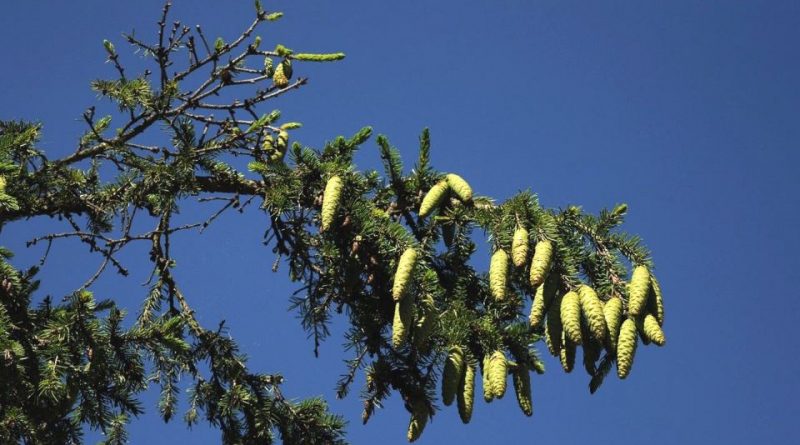Picea neoveitchii
Picea neoveitchii
The Veitch spruce (Picea neoveitchii Mast., 1903) is an arboreal species belonging to the Pinaceae family.
Systematic –
From a systematic point of view it belongs to:
Eukaryota domain,
Kingdom Plantae,
Pinophyta Division,
Class Pinopsida,
Pinales Order,
Pinaceae family,
Genus Picea,
Species P. neoveitchii.
Etymology –
The term Picea comes from picea, the Latin name of the wild pine in Virgil and Pliny; according to an etymological interpretation, it should derive from Pix picis = pitch, in reference to the abundant production of resin.
The specific epithet neoveitchii is in honor of John Gould Veitch, a British explorer and plant breeder who contributed to the discovery and introduction of many new plant species from East Asia in the 19th century.
Geographic Distribution and Habitat –
Picea neoveitchii is a conifer endemic to central China. Several scattered communities and individuals can be found growing on the southern slopes of the Qinling Mountains in Baotian Man Nature Reserve, Henan Province, between 1240 and 2020 meters altitude. The sub-population located in the north-west of Hubei is the main one with around 150 mature individuals, while there are only six specimens in the south of Gansu. Another 3 Veitch spruces are found isolated in Neixiang County (Henan), while two mature specimens are known in southern Shaanxi.
Its habitat is that of medium mountain areas from 1200 to 2250 m above sea level, on rocky slopes, in association with other conifers such as Pinus armandii, Picea asperata, Tsuga chinensis, Abies chensiensis and deciduous trees such as Rhus vernaciflua, Betula luminifera, Betula insignis and Sorbus folgneri.
Description –
Picea neoveitchii is a tree that grows up to 15 m in height, with a vast and conical crown.
The trunk can reach about 50 cm in diameter and with gray bark divided into plates.
The shoots are robust, glabrous or rarely with scattered pubescence, initially pale yellow in colour, then gray or grey-yellow in the second or third year of age; the pulvini are small, facing forward or almost erect.
The leaves are needle-like, 1.5-2 cm long, linear, usually curved, with a rhombic transverse section, with sharp and pungent tips, dark green in color with whitish stomatal bands; the leaves have stomata on both pages, arranged in 4-7 lines. The buds are ovoid-conical or conical, 5-6 mm long, non-resinous; the perulae are triangular, obtuse, brown in colour, slightly pubescent at the base.
The male strobili are formed in the axillary position, are 2 cm long, yellowish in colour.
The female cones are initially erect, then drooping; they grow in a terminal position, with an oblong-ovoid shape, they are sessile, 8-14 cm long and 4.6-6.5 cm wide, with obtuse tips, green when immature, then yellowish-brown. The macrosporophylls are few, large, convex, largely obovate or spatulate near the apex, 2.5-3.2 cm long, with a finely striated abaxial surface and well-defined apophysis; the upper margin is entire, rounded or slightly obtuse, curved and often wavy. The bracts are ligulate, rudimentary, purple, 4-5 mm long and entirely included.
The seeds are ovoid-oblong, dark brown in color, 5-7 mm long, with an obovate winged part, 15-18 mm long, light brown in color.
Cultivation –
Picea neoveitchii is a very rare conifer native to some mountain areas located in central China.
Trees are grown only in Xi’an Botanical Garden and Shanghai Chenshan Botanical Garden; there are less than 10 little plants here.
At a natural level, the only sub-population capable of regenerating is the main one located in Hubei (which is also unprotected), while the others, consisting of a few individuals and scattered, show no signs of reproduction. The primary range is estimated at approximately 9 km². To save the species, a program is underway that involves the ex situ planting of cultivated specimens. It is classified as critically endangered in the IUCN Red List.
Customs and Traditions –
Picea neoveitchii was first described by Maxwell Tylden Masters and published in The Gardeners’ Chronicle, a weekly illustrated journal of horticulture and related subjects.
Its wood was used locally. The rarity of the species has not allowed its introduction to other continents and only about ten specimens cultivated in two Chinese botanical gardens are known.
For this reason this spruce species is particularly vulnerable to extinction due to the high fragmentation of its natural habitat due to human disturbance. Current conservation efforts focus on preserving natural habitats, managing invasive species to reduce competition, and banning timber harvesting. Environmental researchers highlight the urgent need for a restoration project that reintroduces seedlings to the tree’s original range (within protected forest areas) and protects wild communities and individuals. (Zhang et al. 2006).
Preparation Method –
Picea neoveitchii could be used for its timber but the small number of its specimens and the narrowness of its natural range bring this species to the attention of the scientific community in order to protect it and safeguard it from extinction.
Guido Bissanti
Sources
– Acta Plantarum – Flora of the Italian Regions.
– Wikipedia, the free encyclopedia.
– GBIF, the Global Biodiversity Information Facility.
– Useful Tropical Plants Database.
– Conti F., Abbate G., Alessandrini A., Blasi C. (ed.), 2005. An annotated checklist of the Italian vascular flora, Palombi Editore.
– Pignatti S., 1982. Flora d’Italia, Edagricole, Bologna.
– Treben M., 2000. Health from the Lord’s Pharmacy, Advice and experiences with medicinal herbs, Ennsthaler Editore.
Photo source:
– https://powo.science.kew.org/taxon/urn:lsid:ipni.org:names:262692-1/general-information
– https://id.digitarium.fi/api/C.7876/Preview001.jpg
Attention: Pharmaceutical applications and food uses are indicated for informational purposes only, they do not represent in any way a medical prescription; we therefore decline any responsibility for their use for healing, aesthetic or food purposes.


